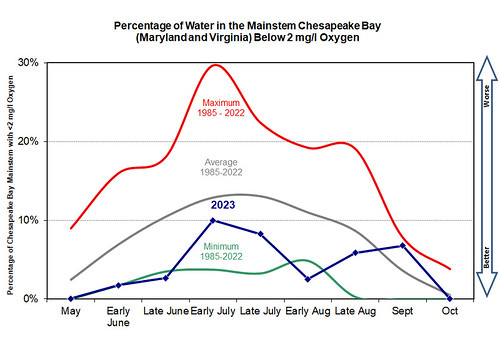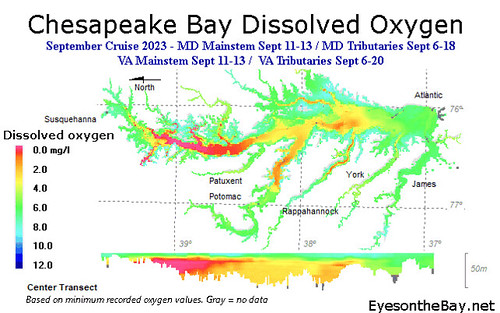Chesapeake Bay 2023 Final Hypoxia Report
This summer’s dissolved oxygen levels in the Chesapeake Bay were much better than previous years
 Water monitoring data collected by the Maryland Department of Natural Resources (DNR) and Old Dominion University show that dissolved oxygen conditions in the Chesapeake Bay mainstem of Maryland and Virginia were much better than average for May-October 2023.
Water monitoring data collected by the Maryland Department of Natural Resources (DNR) and Old Dominion University show that dissolved oxygen conditions in the Chesapeake Bay mainstem of Maryland and Virginia were much better than average for May-October 2023.
The hypoxic water volume — waters with less than 2 milligrams per liter (mg/l) oxygen — averaged 0.52 cubic miles during May-October 2023, compared to the historical average (1985-2022) of 0.97 cubic miles. This year had the lowest average hypoxic volume since monitoring began 39 years ago.
 “This year’s Chesapeake Bay dissolved oxygen conditions are the best on record, and it is encouraging news,” said Mark Trice, program chief of water quality informatics with Maryland DNR’s Resource Assessment Service. “These results illustrate that nutrient input reductions can produce a significant improvement for fish, crab and oyster habitats, and that we need to continue and advance our management efforts throughout the watershed.”
“This year’s Chesapeake Bay dissolved oxygen conditions are the best on record, and it is encouraging news,” said Mark Trice, program chief of water quality informatics with Maryland DNR’s Resource Assessment Service. “These results illustrate that nutrient input reductions can produce a significant improvement for fish, crab and oyster habitats, and that we need to continue and advance our management efforts throughout the watershed.”
Dissolved oxygen was better than average in May through August, with early August having the lowest volume of hypoxia ever measured during that time period. Hypoxia remained into September with worse than average conditions of 0.84 cubic miles observed versus a September historical average of 0.45. No hypoxia was observed in October, even though Maryland’s cruise data was collected in the first week of the month.
Seasonal hypoxia in the Chesapeake Bay mainstem can be forecasted based on freshwater flow into the Bay from January through May. Freshwater flow is an indicator of how much nutrient (nitrogen and phosphorus) runoff may be entering the Bay. However, conditions such as wind, temperature, and precipitation, can provide some influence over the variability of observed hypoxic volumes in the summer.
Chesapeake Bay annual mean freshwater inflows, as estimated by the U.S. Geological Survey (USGS), were near the historical lowest 25th percentile for the 2023 water year, which spans from October 1, 2022 to September 30, 2023. Inflows were mostly below average January through June 2023, and above average July – September 2023. Summer (June – August 2023) precipitation data from the National Oceanic and Atmospheric Administration’s National Centers for Environmental Information (NOAA – NCEI) was near average in Maryland, while Pennsylvania experienced rainfall 3.4 inches above the 129-year state average, with most of the excess occurring in July and August to account for the higher summer inflows.
The NOAA-NCEI also reported that Maryland monthly average air temperatures were above average from June through September 2023 ranking as the 29th hottest in 129 years. Winds were near average during the summer with no major tropical storms or hurricanes. Warmer air leads to warmer Bay waters, which in turn hold less oxygen and support higher rates of oxygen consumption by microorganisms. These higher temperatures and lack of major wind events that aid mixing of oxygen into deeper waters, could have prevented even better dissolved oxygen conditions.
Maryland and Virginia combined results are presented for the mainstem Bay to be more comparable to the yearly seasonal forecast by the U.S. Environmental Protection Agency’s Chesapeake Bay Program, USGS, University of Maryland Center for Environmental Science, and University of Michigan.
The 2023 forecast, released in late June, predicted Chesapeake Bay mainstem hypoxic volume to be 33% lower than the 38-year average due to reduced riverine nutrient loading from January through May 2023. The decreased amount of nutrients entering the Bay can be attributed to lower than average spring precipitation, as well as nutrient management efforts. Maryland and Virginia’s 2023 monitoring results closely matched the forecast of better-than-average conditions. The monitoring and seasonal forecast results also closely matched the better-than-average conditions predicted from computer modeling conducted at the Virginia Institute of Marine Science.
Crabs, fish, oysters, and other creatures in the Chesapeake Bay require oxygen to survive. Scientists and natural resource managers study the volume and duration of Bay hypoxia to determine possible impacts to bay life, and track improvements due to nutrient management efforts.
Each year, DNR computes hypoxia volumes from the water quality data collected by DNR and Virginia Department of Environmental Quality. Water quality data collection occurs year round, and is funded by these states and the Chesapeake Bay Program. Bay hypoxia reporting will resume in May 2023. Additional Maryland water quality data and information, including DNR’s hypoxic volume calculation methods, can be found at DNR’s Eyes on the Bay website.

 1-888-373-7888
1-888-373-7888 233733
233733